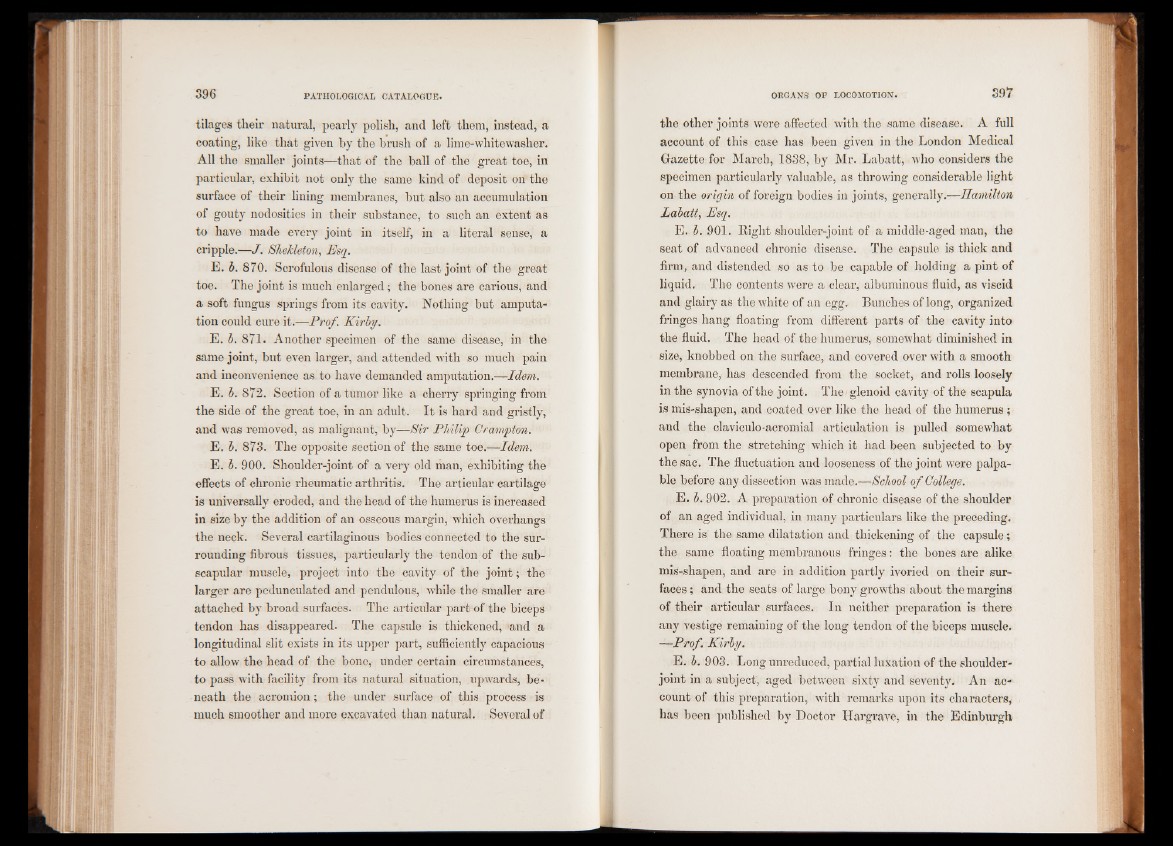
tilages their natural, pearly polish, and left them, instead, a
coating, like that given by the brush of a lime-whitewasher.
All the smaller joints—that of the ball of the great toe, in
particular, exhibit not only the same kind of deposit on the
surface of their lining membranes, but also an accumulation
of gouty nodosities in their substance, to such an extent as
to have made every joint in itself, in a literal sense, a
cripple.—J. SheJcleton, Esq.
E. 1. 870. Scrofulous disease of the last joint of the great
toe. The joint is much enlarged; the bones are carious, and
a soft fungus springs from its cavity. Nothing but amputation
could cure it.—Prof. Kirby.
E. b. 871. Another specimen of the same disease, in the
same joint, but even larger, and attended with so much pain
and inconvenience as to have demanded amputation.—Idem.
E. b. 872. Section of a tumor like a cherry springing from
the side of the great toe, in an adult. It is hard and gristly,
and was removed, as malignant, by-—Sir Philip Crampton.
E. b. 873. The opposite section of the same toe.-—Idem.
E. b. 900. Shoulder-joint of a very old man, exhibiting the
effects of chronic rheumatic arthritis. The articular cartilage
is universally eroded, and the head of the humerus is increased
in size by the addition of an osseous margin, which overhangs
the neck. Several cartilaginous bodies connected to the surrounding
fibrous tissues, particularly the tendon of the subscapular
muscle, project into the cavity of the joint; the
larger are pedunculated and pendulous, while the smaller are
attached by broad surfaces. The articular part of the biceps
tendon has disappeared. The capsule is thickened, 'and a
longitudinal slit exists in its upper part, sufficiently capacious
to allow the head of the bone, under certain circumstances,
to pass with facility from its natural situation, upwards, beneath
the acromion; the under surface of this process is
much smoother and more excavated than natural. Several of
the other joints were affected with the same disease. A full
account of this case has been given in the London Medical
Gazette for March, 1838, by Mr. Labatt, who considers the
specimen particularly valuable, as throwing considerable light
on the origin of foreign bodies in joints, generally.—Hamilton
Labatt, Esq.
E. b. 901. Right shoulder-joint of a middle-aged man, the
seat of advanced chronic disease. The capsule is thick and
firm, and distended so as to be capable of holding a pint of
liquid. The contents were a clear, albuminous fluid, as viscid
and glairy as the white of an egg. Bunches of long, organized
fringes hang floating from different parts of the cavity into
the fluid. The head of the humerus, somewhat diminished in
size, knobbed on the surface, and covered over with a smooth
membrane, has descended from the socket, and rolls loosely
in the synovia of the joint. The - glenoid cavity of the scapula
is mis-shapen, and coated over like the head of the humerus ;
and the claviculo-acromial articulation is pulled somewhat
open from the stretching which it had been subjected to by
the sac. The fluctuation and looseness of the joint were palpable
before any dissection was made.—School of College.
E. b. 902. A preparation of chronic disease of the shoulder
of an aged individual, in many particulars like the preceding.
There is the same dilatation and thickening of the capsule;
the same floating membranous fringes: the bones are alike
mis-shapen, and are in addition partly ivoried on their surfaces
; and the seats of large bony growths about the margins
of their articular surfaces. In neither preparation is there
any vestige remaining of the long tendon of the biceps muscle.
—Prof. Kirby.
E. b. 903. Long unreduced, partial luxation of the shoulder-
joint in a subject, aged between sixty and seventy. An account
of this preparation, with remarks upon its characters,
has been published by Doctor Hargrave, in the Edinburgh